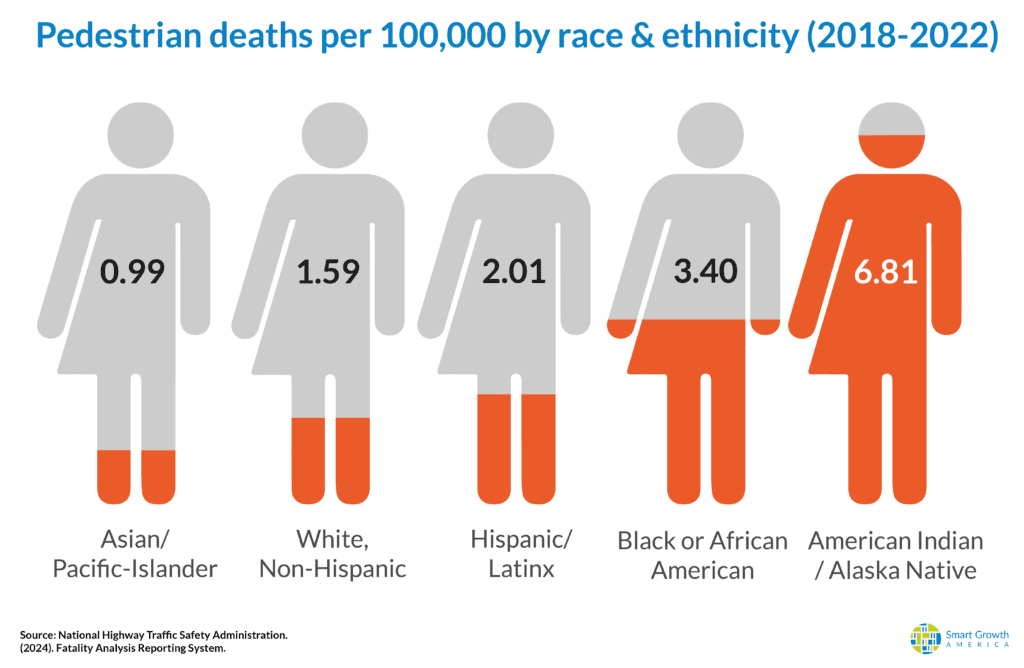Pedestrian Fatalities In Indian Nation: Responding To A Disaster


The most recent Harmful by Design report from Good Development America highlights a tragic inequity – American Indian and Alaska Native people are greater than thrice as prone to be killed whereas strolling than the common American.
What’s going to it take to reverse that? During the last three years America Walks has been working immediately with tribal representatives to know the problems and develop methods to make Native communities safer.
The underlying trigger just isn’t laborious to search out. Multi-lane high-speed roads positioned close to houses, faculties, companies, and different locations are a typical panorama in Indian Nation and within the city and suburban areas of cities the place Native People have been forcibly relocated. Such roads, irrespective of the place they’re discovered, have confirmed to be the deadliest. The discriminatory influence on Native People is a part of a sample of hurt. African American and Native American communities, these with decrease incomes, seniors and people with disabilities additionally undergo from this publicity to roads designed to prioritize velocity over security.
To make it worse, states, counties or cities largely management street engineering choices, even when the roads run by way of tribal communities. Any technique to undo hurt will due to this fact require not simply cooperation amongst a number of governments, but additionally a willingness amongst these governments to problem their very own previous practices.
We’ve now hosted two Coverage Spherical Tables on Tribal Pedestrian Security which have included tribal authorities leaders, planners and engineers, public well being professionals, state and federal DOT officers, educational researchers, and advocates. Listed here are a few of their strategic suggestions:
- UNDERSTAND HISTORY: Acknowledge that Native communities have skilled intentional hurt, damaged guarantees, and systemic racism. In consequence, there’s a lack of belief between tribal governments and U.S. federal, state, and county governments. Historic harms have to be acknowledged and fairness have to be centered all through the dialogue.
- EDUCATE DECISION MAKERS: Develop technical steerage supplies and a complete coaching program on learn how to construct roads and streets in tribal communities in order that autos are operated at decrease speeds.
- DEMONSTRATE and EVALUATE: Set up “Fast-Construct” demonstration gateway or roundabout tasks that are designed to scale back site visitors speeds in tribal communities (also referred to as “site visitors calming pop-ups”).
- ELEVATE NATIVE VOICES: Acknowledge that every tribe is exclusive, give tribal communities larger management over street designs, and make the Coverage Spherical Desk on Tribal Pedestrian Security an annual occasion.
With our companions, the Pueblo of Jemez, Cherokee Nation, the Northwest Tribal Technical Help Program, and the College of Montana Faculty of Public and Group Well being Science, we’ve got now received funding from the Nationwide Security Council to start implementation of this technique. Along with planning and schooling the undertaking may even embrace a number of non-permanent “Fast-Construct” site visitors calming tasks (“gateways” or roundabouts, for instance) put in in partnering communities. Lastly, communication methods will probably be carried out to encourage engagement by earlier attendees and new officers, advocates, and neighborhood members to take part in extra Nationwide Coverage Spherical Tables on Tribal Pedestrian Security.
If you wish to study extra about tribal pedestrian security and our work, please contemplate becoming a member of our webinar, Pedestrian Fatalities in Indian Nation: Responding to a Disaster on July ninth at 2:00 PM Jap, or attain out to Ian Thomas (ian@americawalks.org) who’s the America Walks employees lead on the undertaking.